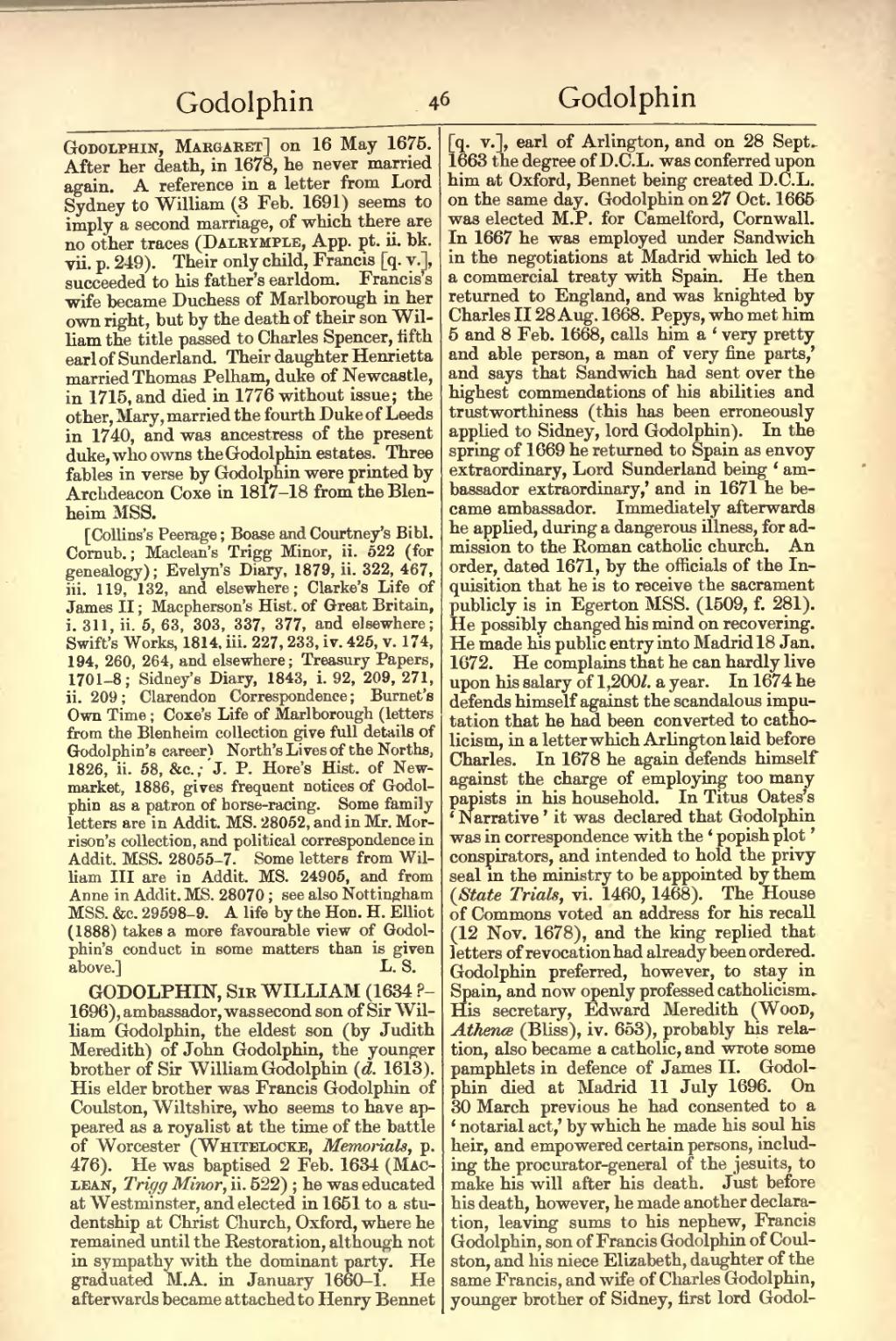Godolphin, Margaret] on 16 May 1675. After her death, in 1678, he never married again. A reference in a letter from Lord Sydney to William (3 Feb. 1691) seems to imply a second marriage, of which there are no other traces (Dalrymple, App. pt. ii. bk. vii. p. 249). Their only child, Francis [q. v.], succeeded to his father's earldom. Francis's wife became Duchess of Marlborough in her own right, but by the death of their son William the title passed to Charles Spencer, fifth earl of Sunderland. Their daughter Henrietta married Thomas Pelham, duke of Newcastle, in 1715, and died in 1776 without issue; the other, Mary, married the fourth Duke of Leeds in 1740, and was ancestress of the present duke, who owns the Godolphin estates. Three fables in verse by Godolphin were printed by Archdeacon Coxe in 1817–18 from the Blenheim MSS.
[Collins's Peerage; Boase and Courtney's Bibl. Cornub.; Maclean's Trigg Minor, ii. 522 (for genealogy); Evelyn's Diary, 1879, ii. 322, 467, iii. 119, 132, and elsewhere; Clarke's Life of James II; Macpherson's Hist. of Great Britain, i. 311, ii. 5, 63, 303, 337, 377, and elsewhere; Swift's Works, 1814, iii. 227, 233, iv. 425, v. 174, 194, 260, 264, and elsewhere; Treasury Papers, 1701–8; Sidney's Diary, 1843, i. 92, 209, 271, ii. 209; Clarendon Correspondence; Burnet's Own Time; Coxe's Life of Marlborough (letters from the Blenheim collection give full details of Godolphin's career); North's Lives of the Norths, 1826, ii. 58, &c.; J. P. Hore's Hist. of Newmarket, 1886, gives frequent notices of Godolphin as a patron of horse-racing. Some family letters are in Addit. MS. 28052, and in Mr. Morrison's collection, and political correspondence in Addit. MSS. 28055–7. Some letters from William III are in Addit. MS. 24905, and from Anne in Addit. MS. 28070; see also Nottingham MSS. &c. 29598–9. A life by the Hon. H. Elliot (1888) takes a more favourable view of Godolphin's conduct in some matters than is given above.]
GODOLPHIN, Sir WILLIAM (1634?–1696), ambassador, was second son of Sir William Godolphin, the eldest son (by Judith Meredith) of John Godolphin, the younger brother of Sir William Godolphin (d. 1613). His elder brother was Francis Godolphin of Coulston, Wiltshire, who seems to have appeared as a royalist at the time of the battle of Worcester (Whitelocke, Memorials, p. 476). He was baptised 2 Feb. 1634 (Maclean, Trigg Minor, ii. 522); he was educated at Westminster, and elected in 1651 to a studentship at Christ Church, Oxford, where he remained until the Restoration, although not in sympathy with the dominant party. He graduated M.A. in January 1660–1. He afterwards became attached to Henry Bennet [q. v.], earl of Arlington, and on 28 Sept. 1663 the degree of D.C.L. was conferred upon him at Oxford, Bennet being created D.C.L. on the same day. Godolphin on 27 Oct. 1665 was elected M.P. for Camelford, Cornwall. In 1667 he was employed under Sandwich in the negotiations at Madrid which led to a commercial treaty with Spain. He then returned to England, and was knighted by Charles II 28 Aug. 1668. Pepys, who met him 5 and 8 Feb. 1668, calls him a ‘very pretty and able person, a man of very fine parts,’ and says that Sandwich had sent over the highest commendations of his abilities and trustworthiness (this has been erroneously applied to Sidney, lord Godolphin). In the spring of 1669 he returned to Spain as envoy extraordinary, Lord Sunderland being ‘ambassador extraordinary,’ and in 1671 he became ambassador. Immediately afterwards he applied, during a dangerous illness, for admission to the Roman catholic church. An order, dated 1671, by the officials of the Inquisition that he is to receive the sacrament publicly is in Egerton MSS. (1509, f. 281). He possibly changed his mind on recovering. He made his public entry into Madrid 18 Jan. 1672. He complains that he can hardly live upon his salary of 1,200l. a year. In 1674 he defends himself against the scandalous imputation that he had been converted to catholicism, in a letter which Arlington laid before Charles. In 1678 he again defends himself against the charge of employing too many papists in his household. In Titus Oates's ‘Narrative’ it was declared that Godolphin was in correspondence with the ‘popish plot’ conspirators, and intended to hold the privy seal in the ministry to be appointed by them (State Trials, vi. 1460, 1468). The House of Commons voted an address for his recall (12 Nov. 1678), and the king replied that letters of revocation had already been ordered. Godolphin preferred, however, to stay in Spain, and now openly professed catholicism. His secretary, Edward Meredith (Wood, Athenæ (Bliss), iv. 653), probably his relation, also became a catholic, and wrote some pamphlets in defence of James II. Godolphin died at Madrid 11 July 1696. On 30 March previous he had consented to a ‘notarial act,’ by which he made his soul his heir, and empowered certain persons, including the procurator-general of the jesuits, to make his will after his death. Just before his death, however, he made another declaration, leaving sums to his nephew, Francis Godolphin, son of Francis Godolphin of Coulston, and his niece Elizabeth, daughter of the same Francis, and wife of Charles Godolphin, younger brother of Sidney, first lord Godol-
